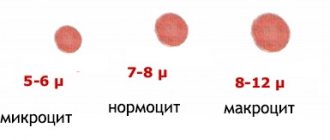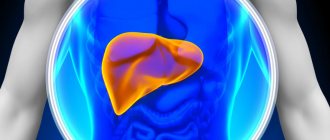LABORATORY DIAGNOSTICS FOR HEART DISEASES
There are three groups of indicators:
— Indicators characterizing risk factors for atherosclerosis;
— Nonspecific indicators of stress reaction and necrosis of the heart muscle;
— “Cardiospecific” indicators of cardiomyocyte death.
The first group includes laboratory signs of atherosclerosis:
1) increase in the level of total cholesterol in the blood > 5 mmol/l;
2) increased LDL cholesterol levels > 3 mmol/l;
3) reduction in HDL cholesterol < 1.0 mmol/l;
4) increase in TG level > 1.7 mmol/l.
Second group:
1) leukocytosis 12 – 15*10 9/l, maximum on days 2 – 4 of myocardial infarction, decreases by the end of the week;
2) increase in ESR from 2 – 3 days;
3) by the end of the first week of myocardial infarction, the graphic representation of the leukocyte level and ESR intersect “scissors symptom”. The level of α2 globulins and fibrinogen increases.
Third group: biomarkers of cardiomyocyte death
1) myoglobin - the earliest indicator - increases after 2 hours.
2) troponins I and T - the “gold standard” of diagnosis. If in the first hours of myocardial infarction the level of troponins is normal, then it is necessary to repeat the analysis after 6–12 hours.
3) creatine kinase - MB fraction - specific, but not sensitive. It increases only with large focal myocardial infarctions.
Determination of the level of AST and LDH is not included in the mandatory diagnostic program, since these enzymes are nonspecific (increased in other conditions). Na and K levels indicate whether there are abnormalities in the heart rhythm. Sputum in cardiovascular failure is scanty, pink, with a large number of reticuloendothelial cells (so-called macrophages). The addition of a secondary infection leads to the development of purulent processes and the appearance of clots of yellowish sputum and mucus, which is always very viscous and thick.
Recommended tests for ischemic heart disease: angina pectoris, myocardial infarction, post-infarction cardiosclerosis, arrhythmias and heart block, heart failure.
1) General blood test - changes during the acute period of MI and its complications (pericarditis, endocarditis, thromboembolism, congestive pneumonia). Leukocytosis, accelerated ESR, and anemia develop.
2) General urine analysis - with congestive heart failure, there may be the appearance of protein, leukocytes, and red blood cells. There is a decrease in urine volume (oliguria), and nocturnal diuresis (nocturia) appears.
3) Biochemical blood test - the content of total cholesterol, cholesterol - LDL, TAG often increases.
4) Blood coagulogram - with ischemic heart disease, as a rule, the blood coagulation system worsens. A number of indicators (APTT, INR), D-dimers and others must be monitored during treatment with anticoagulants (heparin, warfarin, fraxiparin).
5) Markers of heart damage - in case of necrosis of the heart muscle caused by myocardial infarction, the most informative indicator is the determination of troponin, myoglobin, creatine phosphokinase, LDH1,2 fraction (HBDN), CRP (nonspecific test).
6) Blood electrolytes – K, Na, Ca, CL. These indicators must be determined in case of arrhythmias and heart blocks, as well as during treatment with diuretics, which can wash them out of the body and in other concomitant conditions (renal failure).
Recommended tests for myocarditis.
1) General blood test - leukocytosis with a shift of the formula to the left may be observed (the appearance of band neutrophils, an increase in the number of segmented neutrophils). Acceleration of ESR.
2) Biochemical blood test - the content of myocardial enzymes increases - CPK (due to the CPK-MB fraction), LDH (due to the LDH fraction, 1), troponin I. An increase in CRP, an increase in α and β globulins may be observed.
4) Tests for antibodies to viruses that can infect the myocardium are prescribed if a specific infection is suspected. These can be viruses, adenoviruses, influenza, measles, mononucleosis infections, CMV, HIV.
5) Tests for bacteria. The causes of myocarditis can be diphtheria bacillus, streptococcus, staphylococcus, gonococcus, clostridia, etc. Therefore, with a corresponding infection, one should not forget about the effect of these microbes on the heart, especially in severe forms of the disease (sore throat, pneumonia).
4) Other tests for pathogens that cause myocarditis - fungi (candidiasis of the heart), rickettsia, spirochetes, toxoplasma, amoeba, schistosomes, toxoplasma. Syphilis most often affects the valve apparatus of the heart.
For hypertension it is recommended to take:
1) General analysis of blood and urine.
2) Biochemical blood test - including cholesterol, LDL cholesterol, HDL, TAG, creatinine, urea, glucose.
3) Blood electrolytes - especially with periodic monitoring during treatment with diuretics.
4) Coagulogram - with hypertension there is a tendency to increase the blood coagulation system.
Laboratory Diagnostics Doctor, Central House of Writers
Novopolotsk city hospital
Afanasenko A.P.
Express diagnosis of myocardial infarction
Cardiac markers:
05.09.2018
Shibanov A.N., Gervaziev Yu.V.
Myocardial infarction (MI) is one of the main causes of death in civilized countries. According to data presented at the Board of the Ministry of Health and Social Development in 2008, in the structure of causes of mortality in Russia, MI accounts for 20% and ranks second, only slightly inferior to cerebrovascular diseases.
Over the past 20 years, world medicine has made great strides in the treatment of cardiovascular diseases, including MI. Methods such as thrombolytic therapy, reperfusion of the heart muscle, and balloon angioplasty in many cases can restore blood circulation in the heart muscle and save the patient’s life. The effectiveness of these methods depends critically on the time between the onset of acute heart failure and the start of treatment. Every hour of delay significantly reduces the likelihood of a positive outcome. Therefore, timely diagnosis plays an important role in the successful treatment of MI.
Diagnosis of MI is based on 3 groups of criteria:
- history and physical examination;
- instrumental research data;
- determination of cardiac markers in the blood: proteins specific to the infarction state.
History and physical examination data are essentially subjective and cannot serve as criteria for diagnosing myocardial infarction. The purpose of the physical examination is, first of all, to exclude non-cardiac causes of chest pain (pleurisy, pneumothorax, myositis, inflammatory diseases of the musculoskeletal system, chest trauma, etc.). In addition, physical examination reveals heart diseases not associated with damage to the coronary arteries (pericarditis, heart defects), and also assesses hemodynamic stability and the severity of circulatory failure [1].
The key method of instrumental diagnostics is electrocardiography (ECG). The most reliable electrocardiographic signs of MI are the dynamics of the ST segment and changes in the T wave. However, up to 25% of all MI do not cause any changes on the ECG, and from 20% to 30% of all cases proceed without a painful attack, especially in the elderly, as well as in patients diabetes and hypertension.
Therefore, the determination of biochemical markers of myocardial necrosis is a necessary component of the comprehensive diagnosis of MI [1].
The National Academy of Clinical Biochemistry Laboratory Practice of the United States offers a differential diagnosis scheme for acute coronary syndrome, presented in Figure 1 [2].
Figure 1. Diagram of differential diagnosis of acute coronary syndrome.
MI marker proteins
During myocardial necrosis, the contents of the dead cell enter the general bloodstream and can be determined in blood samples.
With the correct selection of these proteins (markers or, more precisely, cardiac markers) based on information about their concentration in the blood, a correct diagnosis can be made. The choice of markers of myocardial necrosis is determined, first of all, by their specificity for a given disease. Also important are such characteristics as the time of appearance in diagnostically significant concentrations in the blood and the time during which their concentration remains elevated. Biomarkers of myocardial necrosis include cardiac troponins I and T (cTnI and cTnT), cardiac fraction of creatine kinase (CK-MB), myoglobin (Myo), lactate dehydrogenase-1 isoenzyme, transaminases and a number of other molecules [3]. Figure 2. Structure of Troponin I.
Troponin I is a protein localized in the heart muscle and involved in its contraction. In the muscle cell there are three forms of troponins - I, T and C, in a ratio of 1:1:1. They are part of the troponin complex, which is associated with the protein tropomyosin. The latter, together with actin, forms thin filaments of myocytes - the most important component of the contractile apparatus of striated muscle cells. All three troponins are involved in the calcium-dependent regulation of contraction-relaxation.
- TnI is the inhibitory subunit of this complex, binding actin during the period of relaxation and inhibiting the ATPase activity of actomyosin, thus preventing muscle contraction in the absence of calcium ions.
- TnT is a regulatory subunit that attaches the troponin complex to thin filaments and thereby participates in the calcium-regulated act of contraction.
- TnS is a calcium-binding subunit and contains four calcium receptor sites.
- TnI and TnT exist in three isoforms, unique in structure for each type of striated muscle (fast, slow and cardiac).
The cardiac isoform of TnI differs significantly from the TnI isoforms localized in skeletal muscle: TnI contains an additional N-terminal polypeptide consisting of thirty-one amino acid residues. Thus, TnI is an absolutely specific myocardial protein. The molecular weight of TnI is about 24,000 daltons.
Cardiac isoforms of both TnI and TnT are used in the diagnosis of myocardial infarction. They can be differentiated from similar skeletal muscle proteins immunologically, using monoclonal antibodies, which is used in methods for their immunotesting.
Cardiac TnS, in contrast to TnI and TnT, is completely identical in structure to muscle TnS and, therefore, is not a cardiac-specific protein.
Figure 3. Structure of creatine kinase.
Creatine kinase is an enzyme that converts phosphocreatine with the formation of creatine and ATP (resynthesis of ATP in the transphosphorylation reaction of ADP and creatine phosphate), which is necessary for muscle contraction.
The total activity of creatine kinase consists of the activity of the enzyme isoforms - CK-MM, CK-BB and CK-MB, where the M is the muscle subunit of the enzyme (muscle) and the B-brain subunit. The CK-BB isoform is mainly present in brain tissue, lungs, and stomach. The CK-MM isoenzyme is characteristic of muscle tissue, and the CK-MB isoform is concentrated in heart tissue. When the heart muscle is damaged, it is this isoform that exits the heart cells into the bloodstream, which is accompanied by an increase in the activity of the isoenzyme in the blood. Figure 4. Structure of myoglobin.
Myoglobin is an iron-containing protein in muscle cells that is responsible for oxygen transport in skeletal muscles and in the heart muscle. An increase in protein levels in the blood is observed 2 hours after the onset of pain during MI. Myoglobin levels are the first of all cardiac markers to increase; the degree of increase depends on the area of myocardial damage. This is the shortest-lived marker of MI - normalization of the indicator usually occurs within 24 hours. This is where its unique diagnostic value lies. If the myoglobin level remains elevated after an acute attack of myocardial infarction, this is evidence of an expansion of the infarction zone. Repeated increases in the level of myoglobin in the blood against the background of normalization that has already begun indicate the formation of new necrotic foci. Thus, myoglobin is very important for diagnosing recurrent myocardial infarction. A significant disadvantage of this marker is its low specificity - it also appears in the blood when skeletal muscles are damaged.
Other potential cardiac markers (lactate dehydrogenase-1 isoenzyme, transaminases, fatty acid binding protein) are practically not used for diagnosing MI for various reasons.
The properties of cardiac markers can be summarized as follows:
| Marker | Molecular weight | Cardio-specificity | Advantages | Flaws | First increase in concentration | Duration of maintaining the increased level |
| CTnT | 37000 | ++++ | High specificity for cardiac tissue. Detection of MI within two weeks. | It is not an early marker of myocardial necrosis. Biphasic kinetics of release into the bloodstream makes it difficult to diagnose recurrent myocardial infarction. | 3-4 hours | 10-14 days |
| CTnI | 23500 | ++++ | High specificity for cardiac tissue. Detection of MI within 7 days. | It is not an early marker of myocardial necrosis. | 4-6 hours | 4-7 days |
| CK-MB | 85000 | +++ | Extensive experience in clinical use. Former “gold standard” for detecting MI. | Reduced specificity for skeletal muscle injury. | 3-4 hours | 24-36 hours |
| Myo | 18000 | Absent | Possibility of excluding MI in the early stages. Possibility of diagnosing recurrent infarctions. | Low specificity for skeletal muscle damage and renal failure. Rapid elimination from the body. | 1-3 hours | 12-24 hours |
Patients with suspected acute myocardial infarction should undergo simultaneous determination of three cardiac markers - troponin, CK-MB and myoglobin.
In urgent situations, in particular in emergency situations, it is preferable to determine cardiac markers using the express method, since the time factor for making a diagnosis is critical.
Currently, the only method that allows rapid determination of troponin, creatine kinase and myglobin is the immunochromatography method (ICA). It allows you to identify disease markers outside of laboratory conditions and within 15 minutes.
Principle of immunochromatographic analysis
The apparatus of the immunochromatographic test is shown in Figure 5.
Figure 5. Schematic representation of the immunochromatographic test.
It consists of the following elements: a filter, a membrane with a conjugate, a chromatographic membrane containing one or more immune complex capture zones and a control capture zone, and an absorption membrane. This entire device is placed in a plastic case, which has a receiving window. The disassembled appearance of the immunochromatographic test is shown in Figure 6.
Figure 6. View of the immunochromatographic test with the body removed.
Visible are a pre-filter, a membrane with a conjugate, a chromatographic membrane, and an absorption membrane. The method is based on thin layer chromatography technology (Figure 7). Blood in a volume of 100 μl (5-6 drops) is applied through a special receiving window onto the sample substrate. Blood plasma, having passed through the filter, under the action of capillary forces, impregnates the strip, where the marker proteins present in the blood plasma react with monoclonal antibodies labeled with colloidal gold, forming antigen-antibody complexes. Colloidal gold is a special dye that is visible even in ultra-low concentrations.
Figure 7. Principle of the immunochromatographic method.
Further, under the action of capillary forces, these complexes move along the chromatographic membrane and react with immobilized antibodies in the corresponding zones against the same proteins. In this case, if the target marker protein is present in sufficient quantity, the colored conjugate associated with the protein accumulates in the zone of immobilization of antibodies against this protein. A kind of “sandwich” is formed (picture). The free conjugate moves across the chromatographic membrane and is captured in the control band by immobilized secondary antibodies. If a sufficient amount of immune complexes accumulates in the capture zones, the stripes, thanks to colloidal gold particles, acquire a characteristic burgundy hue. The control zone is always colored.
If a clear color band does not appear in the control zone, the test result is incorrect, in which case the sample must be retested. In this case, a new test device must be used.
If the capture zones do not contain a single bright color band, and the control zone shows such a band, then the test result is negative.
The test is positive if colored stripes appear in the areas of immune complex capture within 15 minutes. Diagnosticums are designed in such a way that the barely visible presence of a colored band already indicates that the concentration of the marker protein exceeds the threshold level.
Figure 8 shows several clinical cases.
The studies were carried out in the SklifLab laboratory of the Research Institute for Emergency Medicine named after. N.V. Sklifosovsky, where serum samples from patients with suspected myocardial infarction were received from May 18 to May 22, 2009. The three-component cardiotest “ImmunTech” produced by YD Diagnostics, South Korea was used as a test system. Figure 8. Examples of cardiac marker analysis results using an immunochromatographic test.
Explanations in the text. On test A we see only a bright control line; the test does not detect any of the cardiac markers. This analysis result indicates that the likelihood of myocardial infarction in this patient is low. However, it should be pointed out here that a diagnosis cannot be made based on the results of immunochromatographic analysis alone. It is necessary to take into account the entire range of diagnostic information. If there is a clinical picture characteristic of myocardial infarction, the study of cardiac markers should be repeated after 4 and 8 hours.
Test B shows the presence of myoglobin in the patient's blood with a concentration much higher than the detection threshold, very faint coloring of the CK-MB zone is visible, and troponin I is not detected. This test result indicates that the patient's risk of myocardial infarction is quite high. The absence of troponin may be due to the fact that little time has passed since the onset of the process of cardiomyocyte necrosis and troponin has not yet had time to enter the patient’s blood.
Test B shows a characteristic picture of myocardial infarction - all three cardiac markers are present.
On test D we see the presence of staining of the troponin I zone, very weak staining of the creatine kinase MB zone (at the detection threshold) and the absence of myoglobin. The presence of troponin in the patient’s blood indicates that the process of cardiomyocyte necrosis has taken place. The absence of myoglobin and the detection of creatine kinase MB at the sensitivity threshold suggests that, apparently, myocardial infarction occurred more than 96 hours ago.
From the examples given, we see how the efficiency of diagnosing myocardial infarction increases when, along with traditional diagnostic methods, we use the method of immunochromatographic analysis of cardiac markers. This is especially effective when three cardiac markers are determined at once and in dynamics.
In addition to high-quality non-instrumental ICA diagnostics, systems for quantitative instrumental immunochromatographic analysis have been developed. The idea is that these tests use a fluorescent tag instead of a visual dye (colloidal gold), which increases the sensitivity of the test, but requires the use of a special instrument that can quantify the presence of markers. These systems can also work on whole blood, the analysis time is 15-20 minutes. The described systems make it possible to carry out diagnostics directly in the department, at the patient’s bedside. However, the cost of diagnostics is extremely high: up to a thousand rubles for one analysis. The most well-known diagnostic tool for quantitative ICA detection in Russia is the Triage system from Biosite (USA).
The widespread use of immunochromatographic methods for rapid diagnosis of cardiac markers will significantly increase the effectiveness of treatment of myocardial infarction and reduce mortality. Rapid tests must be used in all medical institutions, and not just in cardiology departments of hospitals. In case of any ailment, a person first of all goes to the clinic. If the patient does not have a clearly defined clinical picture of myocardial infarction and there are no clear signs in the cardiogram, not every doctor will decide on urgent hospitalization of the patient. Determining cardiac markers in a clinic will, in some cases, reduce the likelihood of a diagnostic error and allow the doctor to make the right decision. For the same reasons, it is necessary to have rapid tests for diagnosing myocardial infarction in medical and obstetric centers. A positive test result will allow you to reasonably call an ambulance or air ambulance team from the nearest regional center. The small size and weight of immunochromatographic tests allow them to be used by a local doctor or general practitioner when visiting a patient at home.
The relevance of using immunochromatographic rapid tests in emergency medicine is especially high.
It is obvious that the use of such diagnostic methods as computed tomography, ultrasound, various invasive techniques and “classical” laboratory tests in this area is extremely difficult, since the vast majority of emergency cases do not occur in a hospital setting, but in “street” or “home” conditions . In addition, these methods often require preliminary preparation of the patient, which is simply not feasible in an emergency situation. In the Russian Federation, an emergency physician, responding to a call related to any emergency situation, can only rely on the data of a physical examination and the results of electrocardiography, which is not informative in all cases of acute myocardial infarction.
Currently, the requirements for diagnostic methods in emergency medicine, and these are, first of all, quick and accurate results, are most fully met by ICA express diagnostics. This diagnosis can be carried out directly at the point of care for the patient. And given that the time it takes for a patient to be transported by ambulance to the hospital is usually at least 30 minutes, it can be argued that rapid diagnostics will help save the lives of many patients, not to mention reducing the overall cost of treatment.
However, the use of ICA is recommended not only in field conditions. In 2006, American doctors compared the economic indicators of treating patients in a hospital if cardiac markers were determined using immunochromatographic rapid diagnostics and if they were determined in the laboratory. It turned out that despite the relative high cost of express diagnostics, the overall costs of treatment have decreased due to a decrease in the time from blood sampling to obtaining the result. Thanks to this, the costs of medical procedures and pharmacological drugs have decreased, and the length of stay of patients in the hospital has decreased.
Thus, immunochromatographic rapid diagnostics can be recommended for diagnosing MI both in medical institutions and in emergency medicine.
Bibliography.
- Recommendations for the treatment of acute coronary syndrome without persistent ST segment elevation on the ECG. Approved at the Russian National Congress of Cardiologists on October 11, 2001 // https://www.cardiosite.ru/medical/recom-ostcorsin.asp
- Morrow DA, Cannon CP, Jessa RL et al. National Academy of Clinical Biochemistry Laboratory Medicine Practice Guidelines: Clinical Characteristics and Utilization of Biochemical Markers in Acute Coronary Syndromes //Clinical Chemistry 2007. V.53(4). P.552-574.
- Saprygin DB. Current status of the use of myocardial biomarkers of necrosis in acute coronary syndrome. // Laboratory medicine 2009. T.10 P.35-38.
- Apple FS, Chung AY, Kogut ME et al. Decreased patient charges following implementation of point-of-care cardiac troponin monitoring in acute coronary syndrome patients in a community hospital cardiology unit. //Clin Chim Acta. 2006. V.370(1-2). P.191-195.
Tags: Cardiotest, Diagnostics, Prevention of heart attack, Shibanov A.N., Troponins, Three-component Cardiotest "ImmunTech"
« Back to article list Share on
Blood tests that determine the risk of heart attack and stroke
The blood tests below help determine the risk of developing coronary heart disease, stroke , peripheral vascular disease and, if necessary, prescribe treatment.
Lipoprotein A ( Lp (a)) is a blood protein whose levels indicate an increased risk of heart attack and stroke.
Normal value:
Desired level for adults: no more than 30 mg/dl.
Preparing for the analysis:
Blood is taken for analysis after a 12-hour fast (except for drinking water). To get more accurate results, you should refrain from taking the test for at least two months after a heart attack, surgery, infection, injury, or pregnancy.
Lipoprotein A is a low-density lipoprotein (LDL) that has a protein called apo attached to it. Currently, it is not fully known what function lipoprotein A performs in the body, but it is known that blood levels of lipoprotein A higher than 30 mg/dl increase the risk of developing myocardial infarction and stroke. In addition, high levels of lipoprotein A can lead to the development of fat embolism and increases the risk of developing blood clots.
It is especially important to bring the level of LDL (low-density lipoprotein) to normal if the content of lipoprotein A is high. The causes of high levels of lipoprotein A are kidney disease and some familial (genetic) disorders of lipid metabolism. Apolipoprotein A1 (A p o A1) is the main protein of HDL (high density lipoprotein). Low levels of apolipoprotein A1 indicate an increased risk of early cardiovascular disease. Apo 1 is more often reduced in patients suffering from physical inactivity, obesity, or eating a high amount of fat.
Normal value:
Desired level for an adult: more than 123 mg/dl.
Preparing for the analysis:
Blood should be drawn for testing after a 12-hour fast (excluding drinking water). To get more accurate results, you should refrain from taking the test for at least two months after a heart attack, surgery, infection, injury, or pregnancy.
Apolipoprotein B (a p oB) is the main protein found in cholesterol. ApoB is a better overall marker of cardiovascular risk than LDL, a new study suggests.
Normal value:
Less than 100 mg/dL for low/moderate risk individuals. Less than 80 mg/dL for those at high risk, such as those with cardiovascular disease or diabetes.
Preparing for the analysis:
Blood should be drawn for testing after a 12-hour fast (excluding drinking water). To get more accurate results, you should refrain from taking the test for at least two months after a heart attack, surgery, infection, injury, or pregnancy.
Fibrinogen is a protein found in the blood and involved in the blood clotting system. However, high fibrinogen levels may increase the risk of myocardial infarction and vascular disease.
Normal value:
Less than 300 mg/dl.
Preparing for the analysis:
Blood should be drawn for testing after a 12-hour fast (excluding drinking water). To get more accurate results, you should refrain from taking the test for at least two months after a heart attack, surgery, infection, injury, or pregnancy.
Elevated levels of fibrinogen are more often detected in older patients, in patients with high blood pressure, body weight and LDL. On the other hand, lower levels of fibrinogen are detected in patients who drink alcohol and regularly undergo physical activity. An increase in fibrinogen levels occurs with menopause.
High-sensitivity C-reactive protein (protein) (CRP ) is a protein found in the blood that is called an “inflammatory marker,” meaning its presence indicates an inflammatory process in the body. Inflammation is a normal response to many physical conditions, including fever, injury, and infection. But the inflammatory process, localized in the vessel wall, plays an important role in the initiation and progression of cardiovascular diseases. Inflammation (ie, swelling and damage) of the inner wall of the arteries is an important risk factor for the development of cardiovascular diseases such as atherosclerosis, myocardial infarction, sudden death, stroke, blood clots, and peripheral artery disease.
In the Harvard University Health Study, elevated CRP levels were a more accurate marker of coronary heart disease than cholesterol levels. The study assessed twelve different markers of inflammation in healthy postmenopausal women. After three years, C reactive protein was the strongest predictor of risk. Women in the group with the highest CRP levels were more than four times more likely to die from coronary heart disease or suffer a nonfatal heart attack or stroke.
More recently, the JUPITER (Justification for Statins in Primary Prevention) study showed that statins prevent heart disease and reduce the risk of stroke, heart attack, and death in individuals with normal LDL (bad cholesterol) levels but elevated high-sensitivity C-reactive protein (CRP) levels. ).
While elevated levels of cholesterol, LDL and triglycerides and low HDL are independent risk factors for heart disease, high-sensitivity C-reactive protein provides additional information about the inflammatory process in the arteries that cannot be determined by the lipid spectrum.
Normal value:
Less than 1.0 mg/l = low risk of cardiovascular disease; 1.0 - 2.9 mg/l = intermediate risk of developing cardiovascular diseases; more than 3.0 mg/l = high risk of developing cardiovascular diseases.
CRP levels of 50 mg/L or higher are sometimes detected, but usually CRP levels above 10 mg/L are due to another inflammatory process, such as infection, injury, arthritis, etc.
Therefore, testing should not occur during illness or injury. CRP should be studied to assess the risk of developing cardiovascular disease in apparently healthy individuals who have not had a recent infectious disease or other serious illness. Those patients whose CRP level during the study was above 10 mg/l should be examined to identify the source of the inflammatory process.
Preparing for the analysis:
This test can be performed at any time of the day, without any preparation. The only condition is the absence of acute inflammation.
Myeloperoxidase (MPO) is a marker of the inflammatory process in the arteries. As a result of this process, destruction of atherosclerotic deposits in the vessel wall often occurs, leading to thrombosis. A high level of myeloperoxidase, in combination with other risk factors (CRP, LDL, high blood pressure, excess weight) is an accurate criterion for an increased risk of heart attack, myocardial infarction, sudden death, stroke or peripheral vascular disease, including in apparently healthy people .
Normal value:
Less than 400 microns.
Preparing for the analysis:
This test can be done at any time of the day and does not require fasting.
N -terminal pro-brain natriuretic peptide (N-proBNP, NT- proBNT) is a peptide that is produced in the atria and ventricles of the heart in response to increased compliance of cardiomyocytes and increased pressure in the chambers of the heart. By measuring the concentration of NT-proBNP, one can judge the amount of brain natriuretic peptide synthesized. NT-proBNT level correlates closely with left ventricular ejection fraction and pulmonary artery systolic pressure. NT-proBNP levels indicates a high probability of heart failure and the advisability of appropriate examination to confirm the diagnosis.
Normal value:
Less than 125 pg/ml.
Preparing for the analysis:
This test can be done at any time during the day and no fasting is required.
Level of lipoprotein-associated phospholipase (LP-PLA2, PLAC).
High levels of lipoprotein-associated secretory phospholipase a2 (LP-PLA2) indicate an increased risk of developing cardiovascular diseases. However, in some cases, the cause of the elevated levels may not be an arterial cause.
Normal value:
Less than 200 ng/ml - relatively low risk of developing cardiovascular diseases;
Between 200-235 ng/ml - average risk of developing cardiovascular diseases;
More than 235 ng/ml - high risk of developing cardiovascular diseases.
Preparing for the analysis:
Blood should be drawn for testing after a 12-hour fast (excluding drinking water). To get more accurate results, you should refrain from taking the test for at least two months after a heart attack, surgery, infection, injury, or pregnancy.
The ratio of albumin to creatinine in urine. (Ualb/Cr). The appearance of albumin in the urine is a sign of kidney disease, diabetes and cardiovascular complications.
Normal value:
More than 30 mg/g indicates an increased risk of cardiovascular disease and diabetic nephropathy.
More than 300 mg/g indicates clinical nephropathy.
Preparing for the analysis:
A urine test can be done at any time during the day and does not require fasting.










